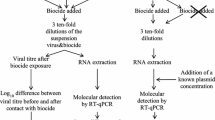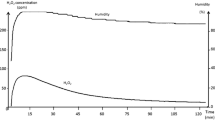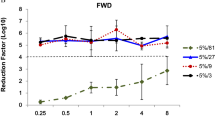Abstract
The aim of this work was to verify the in vitro virucidal activity of VIRKON No Foam (VIRKON NF) against the HBV DNA, notoriously one the most resistant viruses to heat and to the most commonly used disinfectants. VIRKON NF, an oxidizing agent, has a synergic effect on nucleic acids, polypeptides, glycoproteins, and structural proteins. The experiment was conducted using the serum of a patient with HBsAg+/HBeAg+/HBVDNA+ with a DNA concentration 100 pg/ml. The virucidal activity was tested using the Slot Blot method, the result being evaluated as an inhibition of the autoradiographic signal because of contact of different concentrated solutions and various contact times with the serum. Preliminary tests were carried out after contact of VIRKON NF with serum solutions at 0.1–0.5–1–4% concentrations for a 15 min contact time. VIRKON NF showed an inhibition of autoradiographic signal equal respectively to 0%, 25–50%, 50–70%, 100%. Further experiments were carried out to compare VIRKON NF virucidal activity on HBV to the activity of the most common disinfectants, such as formic aldehyde, Amuchina, glutaraledhyde and phenol. In this way, the infected serum was put into contact with both the most common disinfectant and 1– 1.5–2–3–4% VIRKON NF solutions in contact times of 15, 10, 5, 2 min. Using 3% concentrations for a contact time of 10 min, VIRKON NF showed an autoradiographic inhibition signal of 90%. Regarding other disinfectants, only a 2% glutaraldehyde solution for a contact time of 15 min showed similar virucidal activity.
Similar content being viewed by others
References
American Hospital Association: Infection control in the hospital, 3th edn. Chicago: American Hospital, 1974.
Bender GA. Great moments in medicine. Detroit: North Wood Institute Press, 1966.
Castle M. Hospital infection control. New York: Wiley, 1980.
McInnes B. Controlling the spread of infection, 2nd edn. St Louis: Mosby, 1977.
Perkins JJ. Principles and methods of sterilization in health sciences, 2nd edn. Springfield, IL: Charles C. Thomas, 1982.
Spaulding EH, Groschel DHM. Hospital disinfectants and antiseptics. In: Lennet et al. (eds), Manual of Clinical Microbiology, 4th edn. Washington DC: American Society for Microbiology, 1985.
Mullan RJ. Guidelines for prevention of transmission of human immunodeficiency virus and hepatitis B virus health-care and public-safety workers. MMWR 1989: 38.
Bolasco A, Lucarini C, Manna F. Un nuovo sterilizzante chimico a freddo. Nota 1: Caratteristiche chimiche e meccanismo d'azione. Boll Chim Farmac 1992; 131: 386–389.
Block SS. Disinfection, sterilization, and preservation. 4th edn. Philadelphia: London, 1991.
Maniatis T, Fritsch EF, Sambrook J. Molecular Cloning. A laboratory manual, 2nd edn. Cold Spring Harbor Laboratory Press, 1989.
Chuinrudee Y. The virucidal activity of a new type of disinfectant based on an acid peroxigen system. Virus Research Institute, Bangkok. In press.
Thraenhart O, Kuwert EK. Zur Wirksamkeisprufung von Desinfektionsmitteln gegenuber dem Hepatitis B Virus unter besondere Berucksichtigung des MADT. Hyg Med 1984; 9: 385–390.
Thraenhart O, Kuwert EK, Scheiermann N, Dermietzel R, Paar D, Maruhn D, Alberti A, Richter H-J, Hotz J. Comparison of the morphological alteration and disintegration test (MADT) and the chimpanzee infectivity test for determination of hepatitis B virucidal activity of chemical disinfectants. Zentralbl. Bakteriol. Mikrobiol Hyg (B) 1982; 176: 472–484.
Sheretz EF, Davis GL, Rice RW, Harris BA, Franzini DA. Transfer of hepatitis B virus by contaminated reusable needle electrodes after elettrodesiccation in simulated use. J. Am. Acad. Dermatol 1986; 15: 1242–1246.
Siegert W. Die Dane-Partikel asszierte DNA Polymerase: Biochemische Grundlagen und klinische Bedeutung der Hepatitis B. Lab Med 1982; 6: 77–81.
Will H, Cattaneo R, Kock HG, Darai G, Schaler H. Cloned HBV-DNA causes hepatitis in chimpanzees. Nature 1982; 299: 740–742.
Frosner G, Jentsch G, Uthemann H. Zestorung der Anti-genitat und Beeinflussung der immunchemischen Reaktivitat von Antigenen des Hepatitis B-Virus (HBs-Ag, HBc-Ag und HBe-Ag) durch Desinfektionsmittel — ein Prufungsmodell. Zentralbl. Bakteriol 1982; Mikrobiol Hyg (B) 1982; 176: 1–14.
Stonehill AA, Krops S, Borick PM. Buffered glutaraldehyde: A new chemical sterilizing solution. Am. J Hosp Pharm 1963; 20: 458–465.
Woodroof EA. Use of glutaraldehyde and formaldehyde to process tissue heart valves. J Bioeng 1978; 2: 1–9.
Author information
Authors and Affiliations
Rights and permissions
About this article
Cite this article
Scioli, D., Pizzella, T., Vollaro, L. et al. The action of VIRKON No Foam on the hepatitis B virus. Eur J Epidemiol 13, 879–883 (1997). https://doi.org/10.1023/A:1007399926095
Issue Date:
DOI: https://doi.org/10.1023/A:1007399926095




